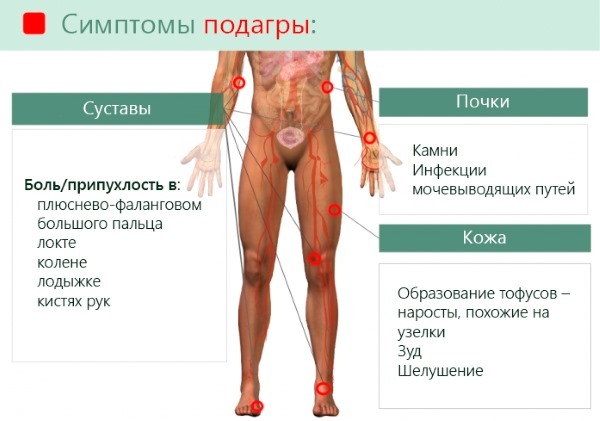The hump on the back is formed as a result of the development of a severe diseases of the musculoskeletal system - kyphosis. Pathology is characterized by a pronounced curvature of the thoracic spine with a displacement of the costal frame, internal organs.
Diagnostics of the back condition is carried out by visual examination of the patient and performing an X-ray examination. If you take a photo of a person who has a hump, you can see that one part of his back is distinguished by a bulge of 40-45 °. People with kyphosis suffer from severe pain in the spine, which occurs during movement and during moments of rest.
Record content:
-
1 Causes of the appearance of a hump on the back
- 1.1 Congenital causes
- 1.2 Acquired reasons
- 2 Development stages and signs
- 3 Possible consequences
- 4 Back hump treatment and orthopedic correction
-
5 Physiotherapy
- 5.1 Daily charging
-
5.2 Exercise therapy at home
- 5.2.1 Exercise "Boat"
- 5.2.2 Exercise "Birch"
- 5.2.3 Stretching the spine on the horizontal bar
- 6 When surgery is indicated
- 7 What operation is performed
- 8 Preparing for the intervention
- 9 Rehabilitation
- 10 Video about kyphosis
Causes of the appearance of a hump on the back
The hump on the back is formed gradually under the influence of one or several factors at once. Kyphosis appears during a person's life, or has an innate nature of origin.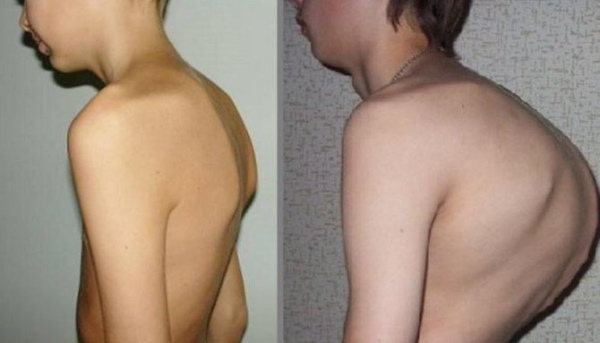
Photographing the back on an X-ray machine makes it possible to detect the first signs of deformational changes in the vertebral structures.
Congenital causes
A hump of an innate nature of origin is much less common than an acquired type of pathology.
In children of the younger age group, the appearance of kyphosis is associated with the influence of the following factors:
- anomalies of intrauterine development;
- genetic predisposition to abnormal formation of the spine, if a similar disease is present in one of the blood relatives;
- birth injuries that are associated with damage to the thoracic spine.
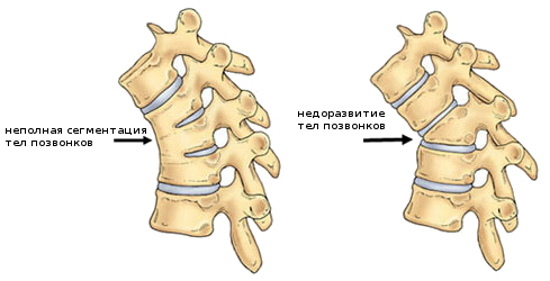 Children with congenital kyphosis initially have a severe curvature of the spine, which progresses rapidly as the child's skeleton develops. In this case, the treatment of pathology is complicated by the age of the patient, as well as by the inability to use a wide range of orthopedic products.
Children with congenital kyphosis initially have a severe curvature of the spine, which progresses rapidly as the child's skeleton develops. In this case, the treatment of pathology is complicated by the age of the patient, as well as by the inability to use a wide range of orthopedic products.
Acquired reasons
A hump on the back (a photo of the disease displays deformational changes in the structure of the spine) can appear in older children, adolescents, adult men and women.
The table below details the main acquired causes of kyphosis:
| Acquired causes of hump formation | Characteristics of pathology |
| Osteoporosis | Osteoporosis is a skeletal disease that is accompanied by the methodical demineralization of bone tissue. As the disease progresses, the density of the vertebrae decreases, which, under the weight of the human body, begin to undergo deformational changes. The main reasons for the development of osteoporosis are hormonal disorders in the body, lack of adequate nutrition, and lack of absorption of minerals. The hump caused by osteoporosis most often affects the back of people over the age of 45. |
| Degenerative arthritis | Degenerative arthritis is a serious condition that causes destruction of the discs and bone in the spine. As a result of the pathological process, the vertebrae are displaced with a progressive curvature of the entire spinal column. This cause of hunchback can lead to severe complications and disability of the patient. Degenerative arthritis can affect children and adults of all age groups. |
| Ankylosing spondylitis | This pathology also occurs under the name ankylosing spondylitis. This disease is characterized by the development of multiple inflammatory processes in the bone and connective tissue of the vertebrae. The joints of the upper and lower extremities are in a painful condition. The main danger of this acquired cause of kyphosis is that ankylosing spondylitis causes not only the formation of a hump, but also is able to deprive a person of the possibility of independent movement. |
| Connective tissue bone injuries | Mechanical damage to the spine can lead to destruction of the vertebrae, as well as the connective tissue of the spinal column. In this case, the size of the hump and the angle of curvature of the spine depend on the nature and severity of the injury. |
| Infectious lesion of the spine | One of the most common causes of hump formation is infection of the bone tissue of the spine with a tuberculosis bacillus. The disease-causing activity of pathogenic microorganisms leads to the destruction of bone and connective vertebral tissues that lose the ability to hold the spine in an anatomically correct position. Curvature of the spinal column with gradual growth of the hump occurs as tuberculosis progresses. |
| Tumors | Benign and oncological neoplasms in the structure of the spine create additional pressure on its vertebrae, violate the integrity of the structure of the bone tissue. Too late diagnosis of pathology leads to deformational changes in the spinal column with the appearance of a bulky hump. In the presence of a malignant tumor, the prognosis for the survival of the patient's life is unfavorable. |
| Paralysis | Paralysis of the muscles of the back, which is responsible for the mobility of the spine, is also one of the causes of acquired humpness. The impact of this factor is due to dysfunctional disorders in the work of the cerebral cortex, a previous stroke, damage to the central nervous system and peripheral nerves by the polio virus. |
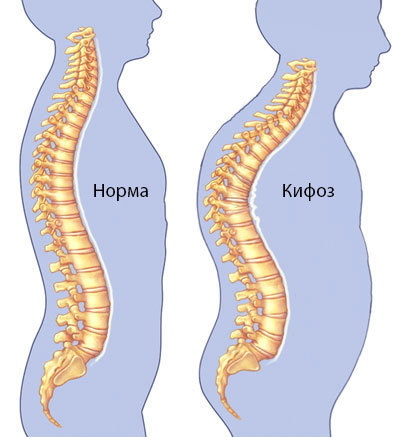 To avoid the development of kyphosis, it is necessary to take timely measures aimed at eliminating the effects of the above factors.
To avoid the development of kyphosis, it is necessary to take timely measures aimed at eliminating the effects of the above factors.
The following people are at increased risk of hump formation:
- adolescent girls with high growth;
- boys between the ages of 10 and 15 who are at the stage of active puberty;
- elderly people suffering from osteoporosis and changes in hormonal levels;
- children and adults who have genetic diseases associated with abnormal development of the connective tissue of the spine (for example, Marfan syndrome).
The hump on the back (the photo shows the main signs of vertebral deformity) does not appear suddenly. The pathological process associated with curvature of the spine can continue for several years. Examination by a traumatologist, orthopedist or surgeon, radiography allows you to detect this pathology, as well as start timely treatment.
Development stages and signs
There are the following degrees of severity of deformation changes in the spinal column, which lead to the formation of a hump:
- 1 degree of the disease is characterized by physiological kyphosis with a curvature of the spine by no more than 20 °;
- 2 degree of pathology is accompanied by deformational changes in the spinal column in the range from 21 ° to 55 °;
- 3 degree of the disease is characterized by a violation of the anatomical location of the spine with its curvature by 56-90 °;
- The 4th degree of kyphosis is considered the most severe, since in this case the vertebrae are displaced by 91 °, or they have an even more pronounced deformation.
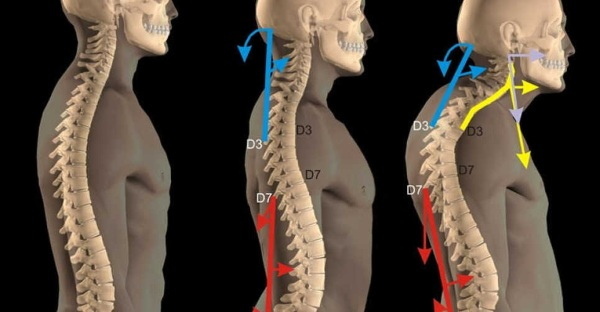
The severity of the curvature of the spinal column is carried out by examining and palpating part of the backwhich has signs of hump formation. Then the patient is assigned an X-ray of the thoracic spine, based on the results of which the final diagnosis is made.
The following signs of the gradual formation of a hump are distinguished:
- pain in the area of curvature of the spine, which is constantly present or occurs after physical exertion;
- progressive stoop;
- leaning the body forward;
- misalignment of the shoulder girdle, hip joints;
- shortening of one of the lower limbs;
- deformational changes in the spine, accompanied by a constant displacement of its vertebrae;
- pronounced bulge of one side of the back, hunched over.
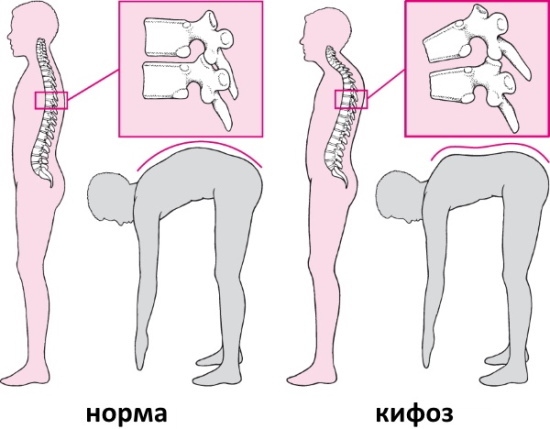
The initial stage of kyphosis develops without the manifestation of painful symptoms.. Despite this, in the process of visual examination of the back, the first signs of a pathological process can be detected. The lack of corrective treatment leads to an aggravation of the above symptoms.
Possible consequences
A hump on the back (a photo of the thoracic spine reflects its pathological condition) can lead to the development of complications and negative consequences for the human body.
Such as:
- compression of the lungs, which causes a constant or intermittent feeling of shortness of breath, shortness of breath after performing minor loads;
- displacement of internal organs towards the curvature of the spine;
- slowing or significant decrease in growth in children who suffer from congenital or acquired kyphosis;
- pathological changes in the structure of the skeleton;
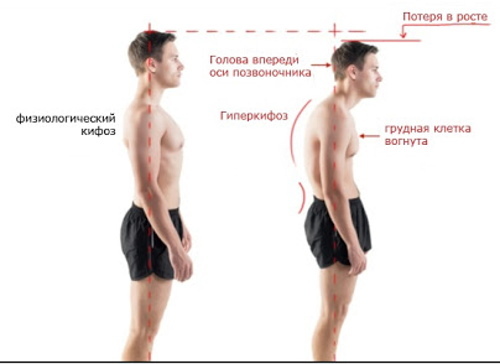
- decreased quality of life;
- the emergence of psychological trauma, complexes of their own inferiority (especially if this pathology has developed in an adolescent child);
- complete or partial loss of performance;
- disturbances in the work of the heart, the tissues of which are squeezed by the bones of the chest with signs of deformation;
- shortening of one of the lower extremities associated with a pronounced skew of the body;
- paralysis of the lower extremities, which is caused by the fact that the deformed vertebrae squeeze the peripheral nerves responsible for the functionality of the musculoskeletal system.
The severity of the consequences of kyphosis depends on how severe the deformational change in the structure of the spine is. The most dangerous complication of this disease is the paralysis of a certain part of the body and confinement to bed, wheelchair.
Back hump treatment and orthopedic correction
Throughout the entire period of kyphosis treatment, the following rules must be observed:
- Make sure to maintain the correct posture while walking.
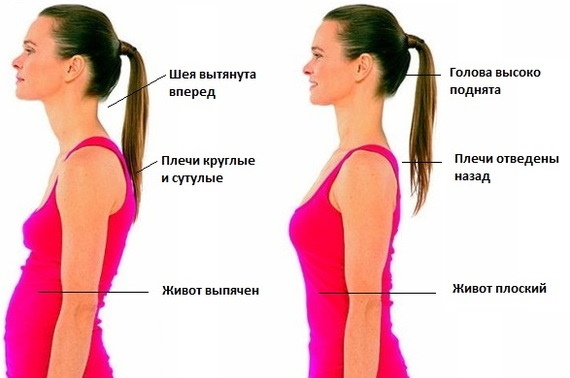
- While in a sitting position, do not roll over to one side, skew the spine.
- Perform therapeutic exercises every morning.
- Sleep on a rigid bed.
- Extend the spine on the horizontal bar.
- Perform regular physiotherapy as prescribed by your doctor.
- Provide the body with high-quality nutrition, rich in proteins, foods containing calcium, phosphorus.
During the course of kyphosis therapy, it is forbidden to lift objects weighing more than 3 kg. Moving heavy weights can speed up the process of vertebral displacement. Before starting treatment for the consequences of curvature of the spine, you will need to undergo examinations for the presence of tumor neoplasms that may be in the structure of its bone and connective fabrics.
Wearing an orthopedic corset is one of the most effective methods of corrective therapy for kyphosis. In order to prevent further growth of the hump, to reduce its size, bone fixation is prescribed.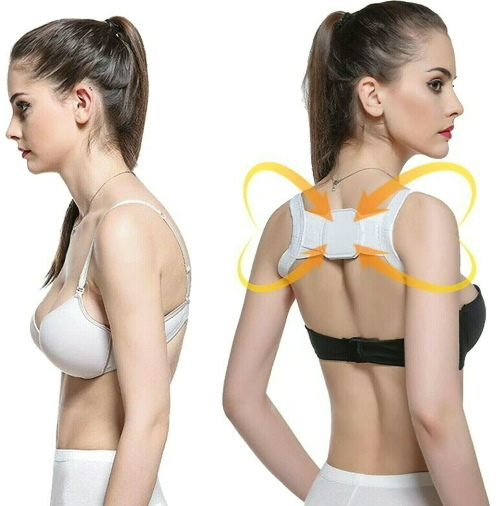
The principle of this method of treatment is that a special corset is put on the thoracic spine. The main purpose of this orthopedic product is to restore the anatomically correct position of the spine.
Daily wearing of a corset allows you to stop the process of deformation of the vertebrae, displacement of internal organs and further growth of the hump.
The selection of a corrective corset is carried out by an orthopedic surgeon after a comprehensive examination of the patient. The rigidity of the orthopedic product is determined on an individual basis, depending on the patient's age, the degree of curvature of the spine, as well as the reasons that caused this pathology.
Wearing a corrective corset is carried out around the clock, or only for a specific period of time. The duration of orthopedic therapy is determined by the doctor. This method of treatment is most effective for eliminating the signs of hump formation in children of the younger age group, adolescents who have symptoms of progressive spinal deformity.
Physiotherapy
Carrying out kyphosis therapy includes daily morning exercises and physiotherapy exercises.
Daily charging
Immediately after waking up from sleep, it is necessary to start performing gymnastics, which is aimed at improving the functions of the musculoskeletal system, maintaining the mobility of the vertebrae with signs of deformity changes.
The daily charging procedure is as follows:
- You need to put your feet shoulder-width apart.
- Grasp the belt with your hands.
- Perform 20 rotational head movements to warm up the cervical spine.
- Make 15 bends forward, to the sides and back.
- Perform 25-30 straightening movements with the shoulder joints, trying to keep the back as straight as possible.
- Perform 25 repetitions of pelvic rotation.
- Perform 20 dilutions of the arms to the sides while simultaneously turning the body to the right and left sides.
Depending on the individual capabilities of each person and the recommendations of the attending physician, it is possible to increase the number of warm-up movements that are performed during this exercise.
Exercise therapy at home
Exercises of physiotherapy exercises can be performed by a person independently, while at home.
Exercise "Boat"
Exercise "Boat" must be done in order to suspend further deformation of the spine, as well as to ensure its alignment.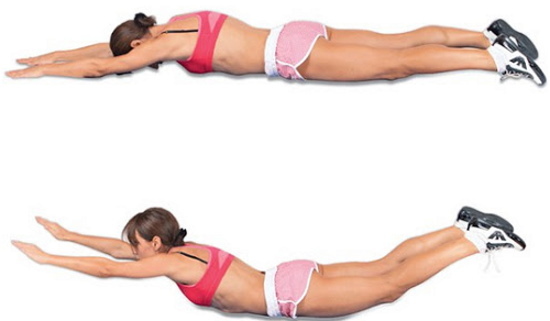
This type of corrective lesson is carried out as follows:
- The patient lies on his stomach.
- Hands are placed along the head in the forward direction.
- The feet are closed together.
- On inhalation, the patient carries out contraction of the back muscles, performing the simultaneous lifting of the upper and lower extremities, accompanied by the deflection of the spine.
- On exhalation, the body returns to its original position.
During 1 session of exercise therapy, it is necessary to do 10-15 repetitions of this exercise in 3-4 approaches.
Exercise "Birch"
To perform this exercise of physiotherapy exercises, you will need to observe the following algorithm of actions:
- Lie on your back.
- Place your hands along the hip joints.
- On inhalation, using the palms of the upper extremities, it is necessary to support the pelvis while lifting the legs up.
- The feet of the lower extremities should be closed together, and the knees should be extended as far as possible.
- After 1-2 minutes. it is necessary to return the body to its original position.
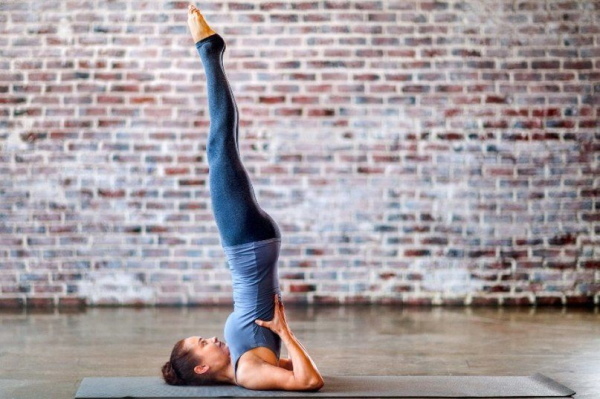 To achieve a positive result in aligning the spine, it is recommended to do 10-12 repetitions. This exercise should be performed on a firm and level surface.
To achieve a positive result in aligning the spine, it is recommended to do 10-12 repetitions. This exercise should be performed on a firm and level surface.
Stretching the spine on the horizontal bar
This type of exercise therapy exercise is performed as follows:
- It is necessary to fix your hands on the bar.
- The feet should be close together and not touching the floor.
- After a deep breath, the patient begins to perform spiral movements of the body.
- After 30-40 seconds, an exhalation is made, and rest is provided for all the muscles of the body.
It is recommended to do 8-10 repetitions of stretching the spine using a horizontal bar. Before performing this exercise, you should stretch your back, arms, and shoulder girdle well.
When surgery is indicated
A hump on the back (a photo of the back makes it possible to see signs of displacement of the vertebrae) is eliminated not only by the method of physiotherapy exercises, but also with the help of a surgical operation.
This method of therapy is radical, and its use is considered appropriate in the presence of the following circumstances:
- the patient is diagnosed with a pronounced curvature of the spine, which cannot be eliminated using other techniques;
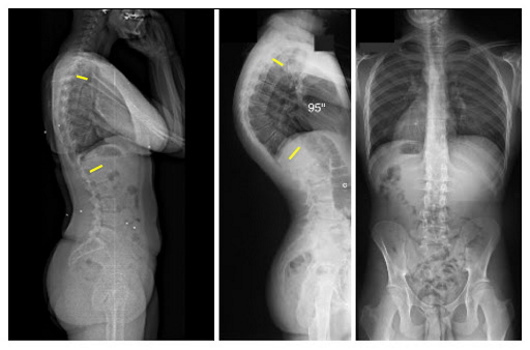
- there is a further progression of kyphosis, accompanied by a violation of the anatomical location of internal organs;
- the patient experiences excruciating pain every day that cannot be stopped with medication;
- paralysis of the lower limbs or other parts of the body has occurred;
- diagnosed with congenital kyphosis in an infant.
Humpback surgery is considered a dangerous and difficult operation.. There is a significant risk of complications, inflammation, infection of the bone and connective tissue of the spine. This type of therapy provides for a long course of rehabilitation.
What operation is performed
Treatment of kyphosis using surgery involves aligning the spine with metal structures.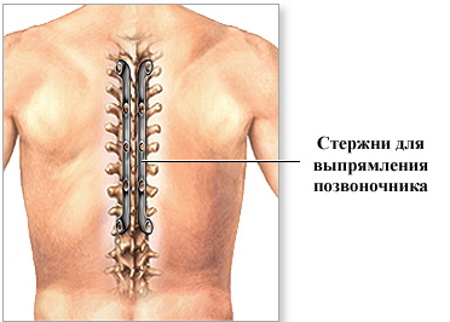
The surgeon restores the anatomically correct location of the vertebrae that have undergone deformational changes. Then they are fastened using screws, titanium plates and special brackets. The operation is performed under general anesthesia.
Preparing for the intervention
Preparation before the operation is carried out in the hospital of the surgical department. The patient undergoes analysis of venous blood, urine. 6-8 hours before surgery, the patient is given a cleansing enema in order to exclude the factor of involuntary defecation under the influence of general anesthesia.
Rehabilitation
The rehabilitation period after surgical treatment of kyphosis lasts about 6 months. depending on the severity of the clinical case.
During this period of time, the following rules must be observed:
- do not lift weights;
- eliminate all risk factors that can cause back injury;
- take a walk in the fresh air;
- sleep on a low pillow;
- use an orthopedic mattress with a rigid base.

After complete restoration of the anatomically correct position of the spine and healing of the bone tissue, a second operation is performed to remove the metal structures.
A hump on the back is a sign of a pathological condition of the spine, which is deformed due to the influence of negative factors. The development of kyphosis affects children, adult men and women, as well as the elderly. There are congenital and acquired causes of hump formation.
Severe curvature of the spine can be triggered by intrauterine abnormalities, genetic predisposition, or birth trauma.
Acquired causes of kyphosis are associated with concomitant diseases of the skeleton, injuries of the spinal column, infection of bone tissue. X-ray photography of the thoracic spine allows you to diagnose the first signs of hump formation, and then form an effective treatment regimen.
Video about kyphosis
Kyphosis - how to straighten your back hump:



